Financial Statement Discussion and Analysis for the year ended March 31, 2015
INTRODUCTION
This Financial Statement Discussion and Analysis (FSD&A) should be read in conjunction with the Financial Statements of the Courts Administration Service (CAS) for the fiscal year ended March 31, 2015. These Financial Statements have been prepared using the Government's accounting policies, which are based on Canadian public sector accounting standards. The FSD&A has been prepared following the Public Sector Statement of Recommended Practice (SORP-1).
Responsibility for the preparation of the FSD&A rests with the management of CAS. The purpose of the FSD&A is to enhance the user’s understanding of the organization’s financial position and results of operations while demonstrating its accountability for its resources. Additional information on the organization’s performance is available in the Departmental Performance Report.
Following this introduction, the FSD&A consists of three sections:
- Overview
- Highlights
- Discussion and Analysis
Please note that all financial information presented herein is denominated in Canadian dollars, unless otherwise indicated.
Special note regarding forward-looking statements
The words “estimate”, “will”, “intend”, “should”, “anticipate”, and similar expressions are intended to identify forward-looking statements that reflect assumptions and expectations of the organization, based on its experience and perceptions of trends and current conditions. Although CAS believes the expectations reflected in such forward-looking statements are reasonable, they may prove to be inaccurate; consequently actual results could differ materially from expectations set out in this FSD&A. In particular, the risk factors described in this report could cause actual results or events to differ materially from those contemplated in forward-looking statements.
OVERVIEW
CAS was established in 2003 by the Courts Administration Service Act, S.C. 2002, c. 8 . CAS’ role is to provide effective and efficient registry, judicial and internal services to the Federal Court of Appeal, the Federal Court, the Court Martial Appeal Court of Canada and the Tax Court of Canada (“the Courts”). The Chief Administrator of CAS serves as Deputy Head.
CAS was created to ensure the effective and efficient provision of administrative support to the four federal courts; to enhance judicial independence by placing administrative services at arm’s length from the Government and affirming the roles of the chief justices and judges in the management of the Courts; and to enhance accountability for the use of public money in support of court administration. This in turn ensures timely and fair access to the judicial system, which is essential to constitutional governance.
CAS’ budget is allocated through authorities approved by Parliament. CAS has one voted authority for program expenditures and statutory authorities for contributions to employee benefit plans, spending of proceeds from the disposal of surplus Crown assets, and refunds of amounts credited to revenues in previous years.
Authorities provided to CAS do not parallel financial reporting according to generally accepted accounting principles since authorities are primarily based on cash flow requirements. Consequently, items recognized in the Statement of Financial Position and in the Statement of Operations and Departmental Net Financial Position are not necessarily the same as those provided through authorities from Parliament. Note 3 of the Financial Statements provides a reconciliation between the bases of reporting.
The Financial Statements of CAS are not audited.
HIGHLIGHTS
Parliamentary Authorities
The parliamentary authorities available for use by CAS include funding received through the Main Estimates, Supplementary Estimates, Transfers, Adjustments and Warrants. These authorities increased by $428 thousand, from $72,147 thousand in 2013-14 to $72,575 thousand in 2014-15. This variance is the result of several factors, as outlined below.
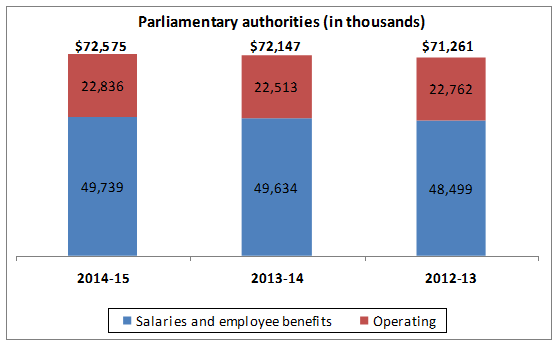
Description of the image
Parliamentary authorities
In 2014-15, Salaries and Employee Benefit Plan authorities were $49,739 thousand. Operating authorities were $22,836 thousand. Total authorities were $72,575 thousand.In 2013-14, Salaries and Employee Benefit Plan authorities were $49,634 thousand. Operating authorities were $22,513 thousand. Total authorities were $72,147 thousand.
In 2012-13, Salaries and Employee Benefit Plan authorities were $48,499 thousand. Operating authorities were $22,762 thousand. Total authorities were $71,261 thousand.
The increase in authorities is partly the result of additional funding received for salary increases related to collective agreements. Funding related to collective agreements increased by $281 thousand compared to the previous fiscal year.
Also, there was an increase of $373 thousand in the transfer from Treasury Board for paylist requirements. This transfer includes severance pay and termination benefits, vacation credits payable upon termination of employment, and parental benefits.
Furthermore, the 2014-15 operating budget carry-forward funding was $231 thousand more than in 2013-14.
In addition, financial resources related to the implementation of Bill C-11, an Act to amend the Immigration and Refugee Protection Act (Balanced Refugee Reform Act) and the Federal Courts Act, increased by $114 thousand.
These increases were offset by a $508 thousand reduction in funding related to the implementation of savings measures announced in Budget 2012.
Various other minor changes resulted in a net $63 thousand decrease in authorities.
Financial Highlights
During fiscal year 2014-15, The Government of Canada implemented salary payments in arrears. As a result, a one-time payment was issued to employees and will be recovered from them in the future. The transition to salary payments in arrears forms part of the transformation initiative that replaces the pay system and also streamlines and modernizes the pay processes. This change to the pay system had no impact on the expenses of the Courts Administration Service. However, it did result in the use of additional spending authorities by the Courts Administration Service. Prior to year end, the transition payments for implementing salary payments in arrears were transferred to a central account administered by Public Works and Government Services Canada, who is responsible for the administration of the Government pay system.
As a result, the following 2014-15 statements and notes were affected by the transitional payment:
- Statement of Operations and Departmental Net Financial Position (Section on government funding and transfers);
- Statement of Cash Flows;
- Note 3 a) Reconciliation of net cost of operations to current year authorities used; and
- Note 10 – Transfer of the transition payments for implementing salary payments in arrears (New)
Statement of Financial Position
The Departmental Net Financial Position is the amount remaining when total liabilities are deducted from total assets. CAS’ Departmental Net Financial Position was $2,548 thousand as at March 31, 2015 ($2,410 thousand as at March 31, 2014).
Liabilities: CAS’ total liabilities were $17,571 thousand as at March 31, 2015 ($15,459 thousand as at March 31, 2014). The $2,112 thousand variance is due to an increase in accounts payable and accrued liabilities, deposit accounts, and employee future benefits, which is partly offset by a decrease in vacation pay and compensatory leave.
Assets: CAS’ assets are presented as financial assets (amount due from the Consolidated Revenue Fund (CRF) account, and accounts receivable and advances) and non-financial assets (tangible assets).
Financial assets: The total net financial assets amounted to $12,362 thousand ($10,347 thousand as at March 31, 2014). The increase of $2,015 thousand is explained as follows:
The year-end balance of the gross financial assets was $13,153 thousand ($11,326 thousand as at March 31, 2014). The variance of $1,827 thousand is primarily due to an increase in the amount due from the CRF, partly offset by a decrease in accounts receivable and advances.
Accounts receivable from non-respendable revenues are not available to discharge liabilities. The corresponding amount of $791 thousand is therefore presented under financial assets held on behalf of Government as a reduction to the gross financial assets.
Non-financial assets: The year-end balance was $7,757 thousand ($7,522 thousand as at March 31, 2014). The increase of $235 thousand is mainly due to prepaid expenses, as well as a smaller increase in tangible capital assets. Tangible capital asset acquisitions of $1,641 thousand were made, offset by amortization of $1,547 thousand and other adjustments of $11 thousand. Leasehold improvements account for 49%, computer hardware and software account for 20%, and machinery and equipment account for 15% of CAS’ tangible capital assets, respectively.Together, these categories account for 84% of CAS’ tangible capital assets.
Statement of Operations and Departmental Net Financial Position
CAS’ net cost of operations before government funding and transfers amounted to $98,149 thousand in 2014-15, an increase of $2,923 thousand (3%) compared to $95,226 thousand in 2013-14. These figures are net of expenses incurred and revenues earned on behalf of government. The increase in total expenses is primarily due to an increase in salaries and employee benefits and accommodations.
Expenses: CAS’ total expenses were $98,149 thousand in 2014-15 ($95,230 thousand in 2013‑14).
Salary and employee benefits: Salary and employee benefit expenses amounted to $53,908 thousand ($53,184 thousand in 2013-14). The $724 thousand (1%) variance is primarily due to a $1,185 thousand increase in the provision for severance benefits as a result of an increase to the severance percentage factor provided by the Treasury Board Secretariat, which is derived from the actuarially determined liability for severance benefits for the Government as a whole. This increase is partly offset by a $304 thousand decrease in salaries and wages, a $133 thousand decrease in employer contributions to employee benefit plans, and other minor variances resulting in a $24 thousand decrease. More than half of CAS’ total expenses consist of salaries and employee benefits.
Operating: Operating expenses totalled $44,241 thousand ($42,046 thousand in 2013-14). The $2,195 thousand (5%) increase is attributable to increases of $1,225 thousand in accommodation, $495 thousand in amortization of tangible capital assets, $299 thousand in machinery and equipment, and other minor variances totalling $176 thousand.
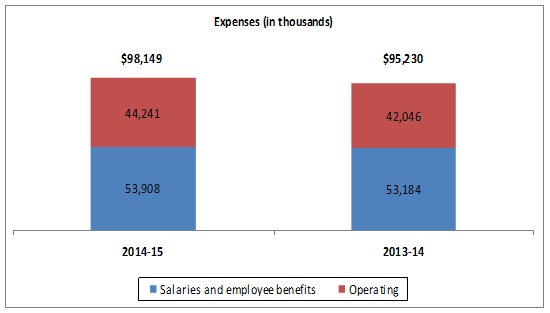
Description of the image
Expenses
In 2014-15, Salaries and Employee Benefit Plan expenses were $53,908 thousand. Operating expenses were $44,241 thousand. Total expenses were $98,149 thousand.
In 2013-14, Salaries and Employee Benefit Plan expenses were $53,184 thousand. Operating expenses were $42,046 thousand. Total expenses were $95,230 thousand.
Revenues: The majority of CAS’ revenues are earned on behalf of Government. Such revenues are non-respendable, meaning that they cannot be used by CAS, and are deposited directly into the CRF. CAS earns a small amount of respendable revenue from the sale of Crown assets. CAS’ gross revenues were $2,597 thousand ($3,018 thousand in 2013-14) and net revenues were nil ($4 thousand in 2013-14), since there were no Crown asset disposals during 2014-15.
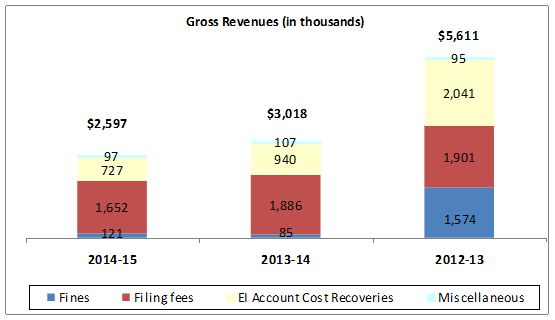
Description of the image
Gross Revenues
In 2014-15, Employment Insurance (EI) Operating Account cost recoveries were $727 thousand. Filing fees revenues were $1,652 thousand. Fines revenues were $121 thousand. Other revenues were $97 thousand. Total gross revenues were $2,597 thousand.
In 2013-14, Employment Insurance (EI) Operating Account cost recoveries were $940 thousand. Filing fees revenues were $1,886 thousand. Fines revenues were $85 thousand. Other revenues were $107 thousand. Total gross revenues were $3,018 thousand.
In 2012-13, Employment Insurance (EI) Operating Account cost recoveries were $2,041 thousand. Filing fees revenues were $1,901 thousand. Fines revenues were $1,574 thousand. Other revenues were $95 thousand. Total gross revenues were $5,611 thousand.
DISCUSSION AND ANALYSIS
Risks and Uncertainties
Funding
During 2014-15, the financial situation of CAS remained difficult and continued to be an important source of risk to the organization’s ability to fulfill its mandate.
For some years, CAS has lacked the permanent funding necessary to enable the organization to fully meet its commitments and address major program integrity issues. Budget 2011 partially addressed this need, providing CAS with approximately $3 million per year for program integrity measures. However, Budget 2014 announced that the operating budgets of departments would be frozen at their 2013-14 level for the years 2014-15 and 2015-16 and as a result, CAS would not receive additional funding for salary increases resulting from newly signed collective bargaining agreements. This is an important consideration given the large proportion of the CAS budget devoted to salaries.
A loan in the amount of $2,750 thousand was provided by Treasury Board in 2011-12 that enabled CAS to address some information technology (IT) rust-out, to construct a data centre and to relocate CAS corporate functions to the designated Federal Judicial Building in the National Capital Region. However, CAS must repay this loan over a five-year period which started in 2012‑13. This represents an important annual funding pressure through 2016-17.
The program integrity issue has been addressed in part through the provision of $19 million in Budget 2015 for physical and IT security. This additional funding is for investment in physical security enhancements such as additional cameras, security personnel and screening tools that will help ensure federal courts remain secure and function properly. It will also enable IT security enhancements to further protect judicial and CAS information.
Historically, funding restraints have severely limited the resources available for strategic initiatives needed to address critical risk areas and allow the organization to become more effective and efficient in its delivery of services to the judiciary and Canadians. Pressures in security will be alleviated by the funding provided in Budget 2015.
Risk Management
Given the challenges of managing financial and other pressures, CAS continued to review its risk assessment and risk management capacity.
Court management is a responsibility of the judiciary and imposes requirements that are beyond CAS’ control. A majority of the non-personnel expenses incurred by CAS are contracted costs for services supporting the judicial process and court hearings. These include translation, court reporters, transcripts and security services, and they are mostly driven by the number, type and duration of hearings conducted in any given year. A risk management strategy to monitor these costs and manage their fluctuation and related impacts on other key areas is in place.
CAS made progress in the provision of security services for the Courts and their users. With the funding announced in Budget 2015, the physical and IT security posture will be further strengthened.
Also, CAS made tangible progress in addressing IT related rust-out, risks and performance. Further work in this area remains to be completed to provide an efficient and robust infrastructure to support the growing needs of the Courts and Registries.
Financial Analysis
The following analysis explains the main items appearing on the financial statements, as well as significant variances and financial trends.
Liabilities
Accounts payable and accrued liabilities: CAS’ accounts payable and accrued liabilities totalled $5,157 thousand as at March 31, 2015 ($3,975 thousand as at March 31, 2014). The increase of $1,182 thousand results from an increase of $1,489 thousand in accrued liabilities, an increase of $149 thousand in accounts payable to other government departments and agencies, partly offset by a decrease of $456 thousand in accounts payable to external parties. The increase in accrued liabilities is mainly due to the Government of Canada’s implementation of salary payments in arrears.
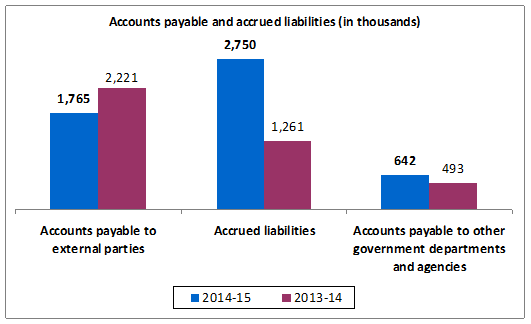
Description of the image
Accounts payable and accrued liabilities
In 2014-15, accounts payable to external parties were $1,765 thousand. Accrued liabilities were $2,750 thousand. Accounts payable to other government departments and agencies were $642 thousand.
In 2013-14, accounts payable to external parties were $2,221 thousand. Accrued liabilities were $1,261 thousand. Accounts payable to other government departments and agencies were $493 thousand.
Vacation pay and compensatory leave: CAS’ vacation pay and compensatory leave year-end balance was $1,845 thousand as at March 31, 2015 ($1,984 thousand as at March 31, 2014). The decrease of $139 thousand is due to the department-wide continued effort to increase the utilization of vacation leave.
Employee future benefits: CAS’ employee future benefits balance was $2,666 thousand as at March 31, 2015 ($2,306 thousand as at March 31, 2014). This amount represents an allowance for severance benefits payable to employees. Beginning in 2011-12, significant changes were made to the severance pay program, whereby benefits for voluntary departures ceased for all employee groups. Employees subject to these changes were given the option to be paid the full or partial value of benefits earned to date or collect the full or remaining value of benefits upon departure from the public service. The $360 thousand increase is the result of an increase to the severance percentage factor provided by the Treasury Board Secretariat, which is derived from the actuarially determined liability for severance benefits for the Government as a whole that takes into account this curtailment and plan settlements to date.
Deposit accounts: CAS’ deposit accounts amounted to $7,903 thousand as at March 31, 2015 ($7,194 thousand as at March 31, 2014). CAS maintains two Specified Purpose Accounts (SPAs), one for deposits by litigants appearing before the Federal Court of Appeal or the Federal Court, and the other for those appearing before the Tax Court of Canada. These two accounts were established pursuant to Section 21.1 of the Financial Administration Act under Order in Council P.C. 1970 4/2 and Order in Council P.C. 1970-300, respectively. Pursuant to an order of the Court, amounts are held in trust and eventually released with accrued interest. Because payments into or out of the accounts are determined by the Courts, depending on the particular case, the balance is unpredictable and may vary significantly from year to year.
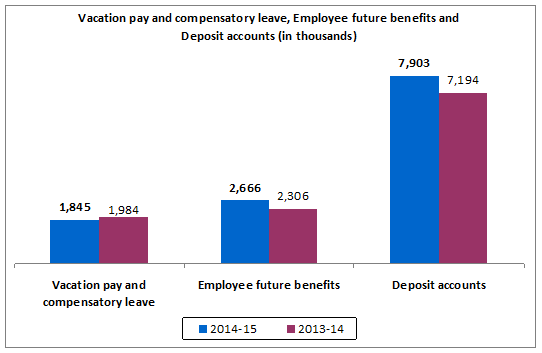
Description of the image
Vacation and compensatory leave
In 2014-15, vacation pay and compensatory leave was $1,845 thousand. Employee future benefits were $2,666 thousand. Deposit accounts were $7,903 thousand.
In 2013-14, vacation pay and compensatory leave was $1,984 thousand. Employee future benefits were $2,306 thousand. Deposit accounts were $7,194 thousand.
Assets
Financial Assets
Due from the Consolidated Revenue Fund: CAS’ due from the CRF year-end balance was $12,058 thousand ($9,765 thousand as at March 31, 2014). The increase of $2,293 thousand is mainly due to a $1,489 thousand increase in accrued salaries and wages and a $709 thousand increase in the deposit accounts. This account represents the net amount of cash that CAS is entitled to withdraw from the CRF in order to discharge its liabilities without generating any additional charges against its authorities in the year of the withdrawal. This includes expenses incurred but not yet paid and amounts received by CAS that can be paid out in future years, offset by accounts receivable from other government departments and agencies.
Accounts receivable and advances: CAS’ accounts receivable and advances balance was $1,095 thousand as at March 31, 2015 ($1,561 thousand as at March 31, 2014). The key components of this balance are accounts receivable from other government departments and agencies, and accounts receivable from external parties, offset by the allowance for doubtful accounts.
- Accounts receivable from other government departments and agencies: The year-end balance was $1,006 thousand ($1,434 thousand as at March 31, 2014). The decrease of $428 thousand is largely due to a $357 thousand decrease in amounts to be received from other government departments for the sale of goods and/or services rendered, including a $213 thousand decrease in the amount allocated to the Employment Insurance (EI) Operating Account, and a $132 thousand decrease related to employer contributions to employee benefit plans. Also, there was a $75 thousand decrease in recoverable amounts related to taxes (GST/HST/QST) and an increase in other minor variances totalling $4 thousand.
- Accounts receivable from external parties: The year-end balance was $87 thousand ($129 thousand as at March 31, 2014). It includes photocopy fees charged to litigants and members of the general public, as well as employees’ overpayments and other adjustments.
- Allowance for doubtful accounts: The year-end balance was $6 thousand ($9 thousand as at March 31, 2014). Over the past several years, CAS has been diligently reviewing and pursing outstanding accounts receivable.
Financial assets held on behalf of Government: Accounts receivable from non-respendable revenues are presented under financial assets held on behalf of Government in reduction of the gross financial assets. The year-end balance was $791 thousand ($979 thousand as at March 31, 2014). The $188 thousand decrease reflects a $213 thousand decrease in the amount allocated to EI Operating Account, offset by various minor amounts totalling $25 thousand.
Departmental Net Debt
The Departmental Net Debt (total liabilities less total net financial assets) is an indicator that provides a measure of the future authorities required to pay for past transactions and events. The year-end balance was $5,209 thousand ($5,112 thousand as at March 31, 2014).
Non-financial Assets
Tangible capital assets: CAS’ net book value of tangible capital assets was $7,605 thousand ($7,522 thousand as at March 31, 2014). The variance of $83 thousand represents acquisitions of $1,641 thousand offset by amortization of $1,547 thousand and other adjustments of $11 thousand.
CAS’ capital asset acquisitions of $1,641 thousand ($1,750 thousand in 2013-14) resulted primarily from capital projects ongoing in 2014-15. Tangible capital assets acquisitions were as follows:
- Machinery and equipment purchases totalled $350 thousand;
- Software upgrades and improvements totalled $557 thousand, including assets still under construction;
- IT hardware upgrades totalled $450 thousand;
- The ongoing construction of court-related facilities in the National Capital Region totalled $248 thousand;
- The purchase of a new vehicle totalled $27 thousand; and
- Other minor capital asset acquisitions totalled $9 thousand.
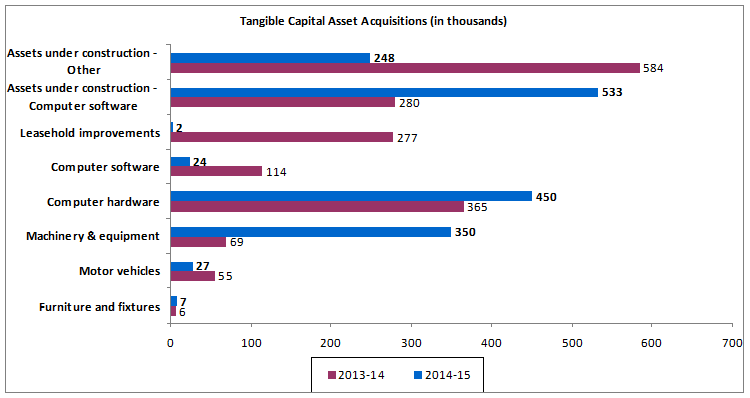
Description of the image
Tangible capital asset acquisition
In 2014-15, furniture and fixture acquisitions were $7 thousand. Vehicle acquisitions were $27 thousand. Machinery & equipment acquisitions were $350 thousand. Computer hardware acquisitions were $450 thousand. Computer software acquisitions were $24 thousand. Leasehold improvements acquisitions were $2 thousand. Assets under construction-computer software acquisitions were $533 thousand. Assets under construction-other acquisitions were $248 thousand.
In 2013-14, furniture and fixture acquisitions were $6 thousand. Vehicle acquisitions were $55 thousand. Machinery & equipment acquisitions were $69 thousand. Computer hardware acquisitions were $365 thousand. Computer software acquisitions were $114 thousand. Leasehold improvements acquisitions were $277 thousand. Assets under construction-computer software acquisitions were $280 thousand. Assets under construction-other acquisitions were $584 thousand.
Expenses
CAS’ total expenses were $98,149 thousand in 2014-15 ($95,230 thousand in 2013-14). The increase of $2,919 thousand (3%) is comprised of increases of $1,225 thousand in accommodations, $724 thousand in salaries and employee benefits, $495 thousand in amortization of tangible capital assets, $299 thousand in machinery and equipment, and $176 other minor variances. The largest categories of expense are: salaries and employee benefits (55% of total expenses in 2014-15, 56% of total expenses in 2013-14); and accommodations (28% of total expenses in 2014-15, 27% of total expenses in 2013-14).
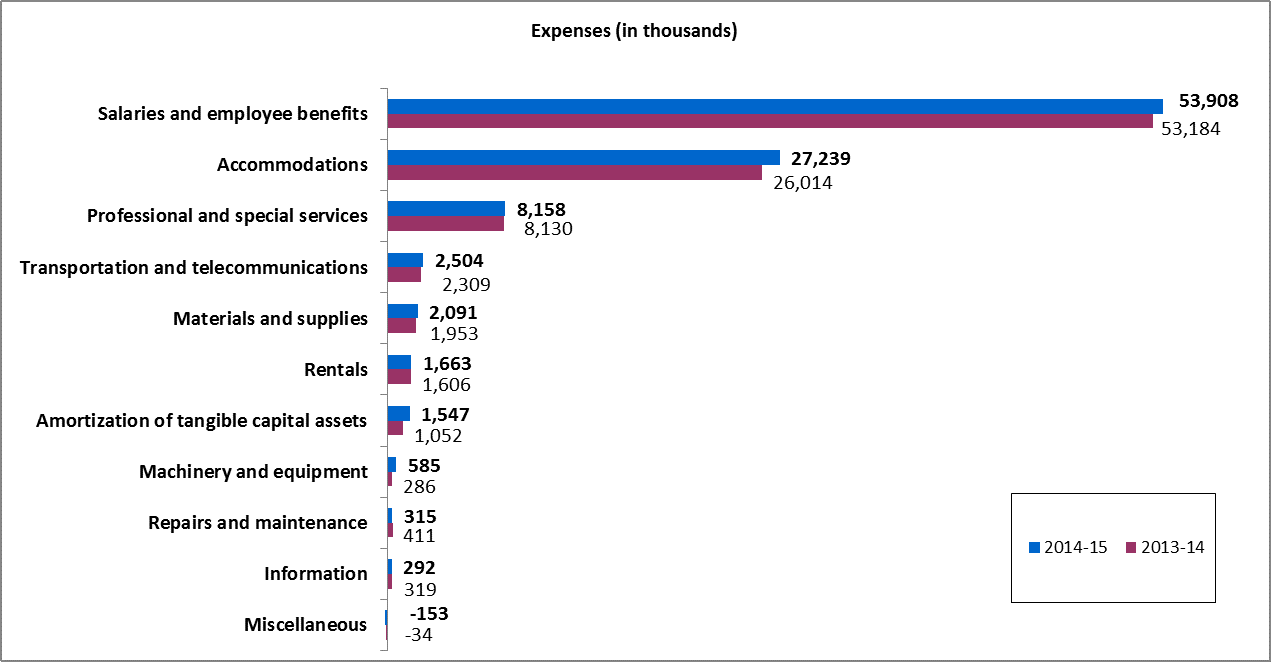
Description of the image
Expenses
In 2014-15, salaries and employee benefits expenses were $53,908 thousand. Accommodation expenses were $27,239 thousand. Professional and special services expenses were $8,158 thousand. Transportation and telecommunications expenses were $2,504 thousand. Materials and supplies expenses were $2,091 thousand. Rentals expenses were $1,663 thousand. Amortization of tangible capital assets was $1,547 thousand. Machinery and equipment expenses were $585 thousand. Repair and maintenance expenses were $315 thousand. Information expenses were $292 thousand. Miscellaneous expenses were -$153 thousand.
In 2013-14, salaries and employee benefits expenses were $53,184 thousand. Accommodation expenses were $26,014 thousand. Professional and special services expenses were $8,130 thousand. Transportation and telecommunications expenses were $2,309 thousand. Materials and supplies expenses were $1,953 thousand. Rentals expenses were $1,606 thousand. Amortization of tangible capital assets was $1,052 thousand. Machinery and equipment expenses were $286 thousand. Repair and maintenance expenses were $411 thousand. Information expenses were $319 thousand. Miscellaneous expenses were -$34 thousand.
Salaries and employee benefits: Salaries and employee benefits expense was $53,908 thousand in 2014-15 ($53,184 thousand in 2013-14). Salaries and employee benefits expense includes such costs as gross salaries and wages, overtime pay, retroactive salary adjustments, employee entitlements and allowances, severance pay, and pension and medical benefits. The $724 thousand variance (1%) is primarily due to a $1,185 thousand increase in the provision for severance benefits as a result of an increase to the severance percentage factor provided by the Treasury Board Secretariat, which is derived from the actuarially determined liability for severance benefits for the Government as a whole. This increase is partly offset by a $304 thousand decrease in salaries and wages, a $133 thousand decrease in employer contributions to employee benefit plans, and other minor variances resulting in a $24 thousand decrease.
Accommodations: Accommodations expense was $27,239 thousand in 2014-15 ($26,014 thousand in 2013-14). This amount represents the value of accommodation services, including rent, provided without charge by PWGSC, a common service organization providing accommodation services to the government. The increase of $1,225 thousand (5%) is principally due to price increases in new lease agreements.
Professional and special services: Professional and special services expense overall was relatively steady with the previous fiscal year. It amounted to $8,158 thousand in 2014-15 ($8,130 thousand in 2013-14). Professional and special services include translation services, protection services, court reporter and transcript services, and IT and telecommunication services.
Transportation and telecommunications: Transportation and telecommunications expense was $2,504 thousand in 2014-15 ($2,309 thousand in 2013-14). The increase of $195 thousand (8%) is attributable to increases in non-public servant travel of $134 thousand and postage expenditures of $56 thousand, with other minor increases of $5 thousand. The increase in non-public servant travel is the result of government-wide coding changes, whereby travel that forms part of contract requirements is no longer coded to professional and special services; instead, it is coded to non-public servant travel, in accordance with the Treasury Board Directive on Travel, Hospitality, Conference and Event Expenditures.
Materials and supplies: Material and supplies expense was $2,091 thousand in 2014-15 ($1,953 thousand in 2013-14). Material and supplies expense includes legal books, publications and subscriptions (except electronic subscriptions), as well as stationery and supplies. The increase of $138 thousand (7%) is due to an increase in the purchase of books, publications and subscriptions by $70 thousand, an increase in the purchase of stationary and office supplies by $44 thousand, and other minor increases totalling $24 thousand.
Rentals: Rentals expense was $1,663 thousand in 2014-15 ($1,606 thousand in 2013-14). The minor increase of $57 thousand (4%) is primarily due to an increase of $88 thousand in the rental of informatics equipment, which includes annual license and maintenance renewal fees. In addition, there were other minor decreases totalling $31 thousand.
Amortization of tangible capital assets: Amortization expense was $1,547 thousand in 2014-15 ($1,052 thousand in 2013-14). Tangible capital assets are expected to yield benefits over several years. Consequently, their cost is amortized on a straight-line basis over the estimated useful life of each asset class. The increase of $495 thousand (47%) reflects the commencement of amortization for assets that were put in use during the 2014-15 fiscal year.
Machinery and equipment: Machinery and equipment expense was $585 thousand in 2014-15 ($286 thousand in 2013-14). The increase of $299 thousand (105%) is due to purchases of assets costing less than $5 thousand such as small computer parts, office equipment, furniture, and motor vehicle parts.
Repairs and Maintenance: Repair and maintenance expense was $315 thousand in 2014-15 ($411 thousand in 2013-14). This decrease of $96 thousand (-23%) is due to a decrease in repairs and maintenance to facilities and IT equipment.
Information: Information expense was $292 thousand in 2014-15 ($319 thousand in 2013-14). The $27 thousand decrease (-8%) is primarily due to a decrease in advertising services of $19 thousand, a decrease in communications professional services of $15 thousand, and other minor increases totaling $7 thousand.
Miscellaneous and Expenses incurred on behalf of Government: Miscellaneous expense was -$153 thousand in 2014-15 (-$34 thousand in 2013-14). In 2014-15, this item includes a loss of public property, interest on overdue supplier accounts, adjustments to the prior year’s payables at year-end (PAYE), and expenses incurred on behalf of Government. The latter relates to bad debts on Accounts Receivable held on behalf of Government. Adjustments to the prior year’s payables are the largest contributors to this decrease.
Revenues
CAS’ gross revenues were $2,597 thousand in 2014-15 ($3,018 thousand in 2013-14). CAS’ revenues may fluctuate widely from year-to-year and consist almost entirely of revenues earned on behalf of Government. Such revenues are non-respendable by CAS and are deposited directly into the CRF. In 2014-15, these non-respendable revenues totalled $2,597 thousand ($3,014 thousand in 2013-14).
CAS’ net revenues were nil in 2014-15 ($4 thousand for 2013-14), since there were no Crown asset disposals during the fiscal year.
Filing fees: Filing fees revenue was $1,652 thousand in 2014-15 ($1,886 thousand in 2013-14). Filing fees are charged to register court documents pursuant to the legislation and Rules governing the Courts.
EI Operating Account cost recoveries: EI Operating Account cost recoveries were $727 thousand in 2014-15 ($940 thousand in 2013-14). At the end of each fiscal year, CAS determines the cost associated with the administration of EI cases for presentation by Employment and Social Development Canada (ESDC), the department responsible for the EI account. Accordingly, ESDC reports an expense in its financial statements and CAS reports an equivalent revenue item. This accounting exercise is intended to reflect the total cost of running the federal government's EI program and does not involve any transfer of authorities or funds.
Fines: Fines revenue was $121 thousand in 2014-15 ($85 thousand in 2013-14). As noted previously, these fines are imposed by the Courts. Consequently, the total amount of fines revenue may vary significantly from year to year and cannot be predicted.
Miscellaneous: Miscellaneous revenue was $97 thousand in 2014-15 ($107 thousand in 2013-14). Miscellaneous revenue is composed of photocopy revenue and other miscellaneous revenues.
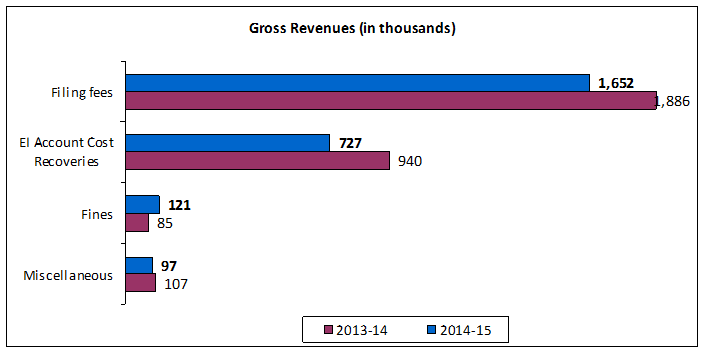
Description of the image
Gross revenues
In 2014-15, Filing fees revenues were $1,652 thousand. Employment Insurance (EI) Operating Account cost recoveries were $727 thousand. Fines revenues were $121 thousand. Other revenues were $97 thousand.
In 2013-14, Filing fees revenues were $1,886 thousand. Employment Insurance (EI) Operating Account cost recoveries were $940 thousand. Fines revenues were $85 thousand. Other revenues were $107 thousand.
- Date modified: